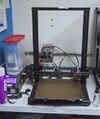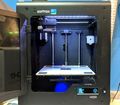Pulse XE: Difference between revisions
m (→Operators' Log: Added changed settings) |
m (→Start G-Code) |
||
| (2 intermediate revisions by the same user not shown) | |||
| Line 28: | Line 28: | ||
=== Start G-Code === | === Start G-Code === | ||
The start gcode of the printer is written in a manner to | The start gcode of the printer is written in a manner to comply with regulatory requirements. Specifically, ABL with the BLTouch is performed on startup every time a new print is started. | ||
It is possible to change the start gcode such that stored ABL data is applied at the start of 3d printing instead. | It is possible to change the start gcode such that stored ABL data is applied at the start of 3d printing instead. | ||
| Line 192: | Line 192: | ||
| Material || Initial Layer Flow || 108% | | Material || Initial Layer Flow || 108% | ||
|} | |} | ||
=== [[User:Blu | BLu]] 2023-05-12 === | |||
It is noted that the PLA that was printed for the IOK event did not yield acceptable results. There may be either under-extrusion or lower-than-acceptable temperatures used on the Pulse XE. Future tests need to be conducted to resolve this issue. | |||
=== [[User:Blu | BLu]] 2023-09-10 === | |||
This event was not logged in a notebook, so there are not a lot of details. | |||
The PulseXE experienced a lot of extrusion issues through multiple prints. "It was both over and under-extruding." This was caused by a misplaced pin in the bondtech extruder. The idle gripper wheel pin needs to be pushed further into the closed end in the tension arm. This fix was applied earlier in the printer's lifecycle and was not documented. | |||
Also noted is the occurrence of molten filament solidification in the extruder caused by over-retraction of the filament into the cold zone. Further tuning of the retraction length shall be performed at a later date. | |||
== Other 3D Printers == | == Other 3D Printers == | ||
Latest revision as of 16:26, 28 December 2023
Operational Information
An operation guide will be written in the near future.
The printer is in a printer enclosure.
Printer Settings
The print volume is recorded in the 3d printer card on this page.
Start G-Code
The start gcode of the printer is written in a manner to comply with regulatory requirements. Specifically, ABL with the BLTouch is performed on startup every time a new print is started.
It is possible to change the start gcode such that stored ABL data is applied at the start of 3d printing instead.
G21 ; set units to millimeters
G90 ; use absolute positioning
M82 ; absolute extrusion mode
G28
M104 S{material_print_temperature_layer_0} ; set extruder temp
M140 S{material_bed_temperature_layer_0} ; set bed temp
M190 S{material_bed_temperature_layer_0} ; wait for bed temp
M109 S{material_print_temperature_layer_0} ; wait for extruder temp
G29 P1; automatic bed probing
G29 P3; outer point interpolation
G29 A; activate ubl system
G92 E0
G1 X5 Y5 Z0.8 F1800
G1 X100 Z0.3 E25 F900
G92 E0
G1 E-2 F2400
End G-Code
M104 S0 ; turn off extruder M140 S0 ; turn off heatbed M107 ; turn off fan G1 X0 Y210; home X axis and push Y forward G28 Z0 M84 ; disable motors
Operators' Log
BLu 2022-09-22
This section contains information based on the initial inspection and acceptance notes of the Pulse XE printer by BLu. This info may be incorrect or otherwise outdated. Please refer to the information preceding this section.
Experiment 1: Matter Control
The printer USB port was not connected to any computer when found on 2022-09-22. BLu connected the printer to the Toaster.
The first Matter Control print attempts with the Pulse XE resulted in a large gap between the bed and the print. After trial and error, a nozzle offset of 3.4mm was found to place the print in the correct Z-offset for bed adhesion. The first print; however, did not print correctly.
The intermittent extrusion problems found during the first print were observed to be solved after extruder motor cleaning. Large amounts of plastic crud were clogging the area inside the extruder and were preventing the extruder gears from maintaining a good grip on the plastic.
A successful ChatLowPoly print was demonstrated after bed level adjustment and extruder cleaning.
Experiment 2: Cura
Extrusion under Cura was inconsistently observed to be far from the bed. The center section of the print would be too close to the bed, but the exterior was found to be too far from the bed.
Further investigation into the printer settings would show the following leveling mesh:
| R\C | 9 | 8 | 7 | 6 | 5 | 4 | 3 | 2 | 1 | 0 |
|---|---|---|---|---|---|---|---|---|---|---|
| 9 | ||||||||||
| 8 | -3.083 | -3.370 | -3.655 | -3.910 | -4.098 | -4.257 | -4.398 | -4.595 | ||
| 7 | -3.080 | -3.355 | -3.633 | -3.880 | -4.073 | -4.205 | -4.375 | -4.585 | ||
| 6 | -3.045 | -3.320 | -3.600 | -3.875 | -4.065 | -4.198 | -4.370 | -4.560 | ||
| 5 | -3.040 | -3.305 | -3.608 | -3.905 | -4.020 | -4.175 | -4.348 | -4.560 | ||
| 4 | -3.013 | -3.285 | -3.575 | -3.902 | -4.028 | -4.182 | -4.368 | -4.570 | ||
| 3 | -3.053 | -3.325 | -3.577 | -3.845 | -4.045 | -4.223 | -4.382 | -4.548 | ||
| 2 | -3.080 | -3.323 | -3.618 | -3.845 | -4.063 | -4.248 | -4.415 | -4.625 | ||
| 1 | -3.122 | -3.395 | -3.650 | -3.885 | -4.115 | -4.310 | -4.467 | -4.668 | ||
| 0 |
The leveling mesh is incomplete, and it was hypothesized that missing values would default to 0 which would cause the printer to print 3.9mm above the bed on average. The missing values were filled in as grey in order to test this hypothesis in the following table:
| R\C | 9 | 8 | 7 | 6 | 5 | 4 | 3 | 2 | 1 | 0 |
|---|---|---|---|---|---|---|---|---|---|---|
| 9 | -3.100 | -3.1000 | -3.400 | -3.700 | -3.900 | -4.1000 | -4.300 | -4.400 | -4.600 | -4.700 |
| 8 | -3.100 | -3.083 | -3.370 | -3.655 | -3.910 | -4.098 | -4.257 | -4.398 | -4.595 | -4.700 |
| 7 | -3.000 | -3.080 | -3.355 | -3.633 | -3.880 | -4.073 | -4.205 | -4.375 | -4.585 | -4.700 |
| 6 | -3.000 | -3.045 | -3.320 | -3.600 | -3.875 | -4.065 | -4.198 | -4.370 | -4.560 | -4.700 |
| 5 | -3.000 | -3.040 | -3.305 | -3.608 | -3.905 | -4.020 | -4.175 | -4.348 | -4.560 | -4.700 |
| 4 | -3.000 | -3.013 | -3.285 | -3.575 | -3.902 | -4.028 | -4.182 | -4.368 | -4.570 | -4.700 |
| 3 | -3.000 | -3.053 | -3.325 | -3.577 | -3.845 | -4.045 | -4.223 | -4.382 | -4.548 | -4.700 |
| 2 | -3.100 | -3.080 | -3.323 | -3.618 | -3.845 | -4.063 | -4.248 | -4.415 | -4.625 | -4.700 |
| 1 | -3.100 | -3.122 | -3.395 | -3.650 | -3.885 | -4.115 | -4.310 | -4.467 | -4.668 | -4.700 |
| 0 | -3.100 | -3.100 | -3.400 | -3.700 | -3.900 | -4.100 | -4.300 | -4.500 | -4.700 | -4.700 |
This hypothesis was true, and the printer was able to print successfully albeit with the printhead still slightly too low.
Analysis of the leveling mesh shows a consistent gradient from the left side to the right side of the mesh. It is possible and likely that the X-axis carriage is misaligned from printer assembly. The Z-axis steppers have no method of self-alignment and must be correctly aligned from assembly in order for the X-axis to be level. Furthermore, the "DC-offset" of -3.9 mm in the table is evident of a missing spacer screw on the Z-axis proximity sensor path. Visual examination of the printer confirms that an empty threaded insert exists in the Z-axis proximity sensor path. These findings will be experimented on further on a later date.
BLu 2022-12-25
The PulseXE is now operational with an attached OctoPi.
Many experiments were performed with startup leveling, and the final leveling startup GCODE is now on Cura 5.1.0 on the Toaster.
BLu 2023-03-09
XZ YACS was not able to be completed completely successfully on the PulseXE due to the nozzle binding on the 45 degree part of the X. The angle on the 45 degree brace would curl upwards and into the 3d printer nozzle. Internet articles such as this one from all3dp suggest that this may be due to insufficient cooling.
The cooling fan speeds on this part were not recorded, but they were reduced in an attempt to combat 3d print warping issues with PETG. They should be increased the next time this print is attempted.
BLu 2023-04-29
A comprehensive list of changed settings from the Cura-provided defaults has not been provided until this point in time. This section exists to resolve that deficiency.
| Section | Setting | Value |
|---|---|---|
| Walls | Z Seam Alignment | Shortest |
| Infill | Infill Density | 60 % |
| Travel | Retract At Layer Change | ✅ |
| Retraction Distance | 3.5 mm | |
| Combing Mode | Not on outer surface | |
| Retract Before Outer Wall | ⬜ | |
| Z hop when Retracted | ✅ | |
| Z hop Only Over Printed Parts | ✅ | |
| Z hop Height | 0.8 mm | |
| Cooling | Fan Speed | 50% |
| Build Plate Adhesion | Build Plate Adhesion Type | Brim |
| Brim Width | 5.0 mm | |
| Walls | Z seam Alignment | Shortest |
| Material | Initial Layer Flow | 108% |
BLu 2023-05-12
It is noted that the PLA that was printed for the IOK event did not yield acceptable results. There may be either under-extrusion or lower-than-acceptable temperatures used on the Pulse XE. Future tests need to be conducted to resolve this issue.
BLu 2023-09-10
This event was not logged in a notebook, so there are not a lot of details.
The PulseXE experienced a lot of extrusion issues through multiple prints. "It was both over and under-extruding." This was caused by a misplaced pin in the bondtech extruder. The idle gripper wheel pin needs to be pushed further into the closed end in the tension arm. This fix was applied earlier in the printer's lifecycle and was not documented.
Also noted is the occurrence of molten filament solidification in the extruder caused by over-retraction of the filament into the cold zone. Further tuning of the retraction length shall be performed at a later date.
Other 3D Printers
This is a part of our effort to document our 3D printers. Here is a collection of our other 3D printers.








